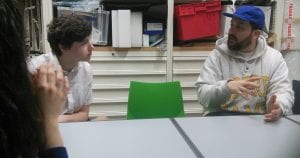Young curators club – week 4: Show and Tell
Written by James O’Donoghue
In two weeks the Young Curators will culminate their weeks of work into an exhibition of their own creation with their own objects paired with artefacts from UCL’s Ethnographic Collection. Here to help this week was specialist in street-art and graffiti, Dr Rafael Schacter. Being an experienced curator, Rafael was here today to teach the Young Curators how to create a story within their exhibition. “An exhibition is like a film, it always has a narrative, or a book that always has a story” he tells the students. Delphine and Rafael then helped the Curators make new connections between their own objects and the ones they chose from the ethnographic collection. They asked the students to think about why their objects were made, and the impact they have on people and space. The final contemplation was how to present this coherently and intriguingly in an exhibition.

To provide an example of an exhibition, the students were then taken to the Cabinets of Consequence exhibition on display in The Octagon, under the canopy of UCL’s iconic dome. The temporary exhibition explores the complex and profound interactions between environment, technology and human, drawing from a range of UCL’s own research to create a really informative and interesting exhibition; an exhibition unfortunately overlooked due to its placement within what is effectively a corridor. For the exhibition, the Curators were given questions, which highlighted to them the importance and roles of text, image, video and artefact in understanding the messages an exhibition is wanting to convey. With robot bees, images of Venus’ surface and paintings of the Four Horsemen of the Apocalypse, they found how objects within an exhibition can be so different, yet, still be meaningfully linked together by an overall narrative.

Finally, the students were tasked with finding out more information on the objects they chose from the Ethnographic collection. Using the wondrous internet, they found out details about the physicality of their objects and their roles within the society, as well as the object’s interplay with human life. One student, who chose a large conch shell from the collection, discovered that many of these shells were not only blown through to create a noise, but in some instances holes have been drilled to create different pitches. Another student found out the markings on jewellery boxes similar to that which she chose are related to deities worshipped by the people who made it. These were the kind of messages they would hope to display in their upcoming exhibition.